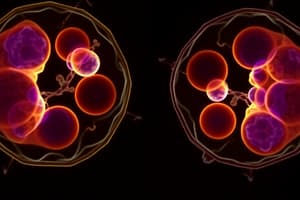Podcast
Questions and Answers
What is the fundamental difference between prokaryotic and eukaryotic cells?
What is the fundamental difference between prokaryotic and eukaryotic cells?
- Eukaryotic cells contain a nucleus. (correct)
- Prokaryotic cells have membrane-bound organelles.
- Prokaryotic cells possess multiple chromosomes.
- Eukaryotic cells are generally smaller.
Which of the following correctly describes prokaryotic cells?
Which of the following correctly describes prokaryotic cells?
- They contain a well-defined nucleus.
- They have DNA enclosed within a nucleus.
- They lack membrane-bound organelles. (correct)
- They are typically larger than eukaryotic cells.
What condition may cause a human cell to have 47 chromosomes?
What condition may cause a human cell to have 47 chromosomes?
- Chromosomal Duplication
- Eukaryotic Overgrowth
- Bacterial Infection
- Down's Syndrome (correct)
Which statement is true regarding eukaryotic cells?
Which statement is true regarding eukaryotic cells?
Where is the DNA located in prokaryotic cells?
Where is the DNA located in prokaryotic cells?
What role does a cell nucleus play in eukaryotic cells?
What role does a cell nucleus play in eukaryotic cells?
How do the structures of prokaryotic and eukaryotic cells compare?
How do the structures of prokaryotic and eukaryotic cells compare?
Which feature is common in all eukaryotic cells?
Which feature is common in all eukaryotic cells?
What happens to homologous chromosomes during Anaphase I?
What happens to homologous chromosomes during Anaphase I?
Which of the following describes Telophase I?
Which of the following describes Telophase I?
What is a key feature of Meiosis II?
What is a key feature of Meiosis II?
What is the primary outcome of cytokinesis during Meiosis II?
What is the primary outcome of cytokinesis during Meiosis II?
How many functional eggs are produced in females during meiosis?
How many functional eggs are produced in females during meiosis?
What does the term 'haploid' refer to in the context of meiosis?
What does the term 'haploid' refer to in the context of meiosis?
What occurs during interphase before meiosis begins?
What occurs during interphase before meiosis begins?
What role does genetic variability play in populations?
What role does genetic variability play in populations?
What property of phospholipids allows them to form a bilayer in cell membranes?
What property of phospholipids allows them to form a bilayer in cell membranes?
How does cholesterol affect phospholipid movement at high temperatures?
How does cholesterol affect phospholipid movement at high temperatures?
What is the role of peripheral proteins in the cell membrane?
What is the role of peripheral proteins in the cell membrane?
What effect does cholesterol have on phospholipids at low temperatures?
What effect does cholesterol have on phospholipids at low temperatures?
Which type of proteins span the entire phospholipid bilayer?
Which type of proteins span the entire phospholipid bilayer?
Which of the following movements of phospholipids occurs most frequently within the bilayer?
Which of the following movements of phospholipids occurs most frequently within the bilayer?
What are glycoproteins and glycolipids primarily responsible for?
What are glycoproteins and glycolipids primarily responsible for?
What is the function of integral proteins in the phospholipid bilayer?
What is the function of integral proteins in the phospholipid bilayer?
What term was coined by Waldeyer in 1888?
What term was coined by Waldeyer in 1888?
What is the total number of chromosomes in humans?
What is the total number of chromosomes in humans?
Which of the following best describes the role of histones in chromosomes?
Which of the following best describes the role of histones in chromosomes?
What is the function of the centromere in chromosomes?
What is the function of the centromere in chromosomes?
What is the name of the specialized cell division that results in the production of gametes?
What is the name of the specialized cell division that results in the production of gametes?
Which of the following statements about extreme pH levels is TRUE?
Which of the following statements about extreme pH levels is TRUE?
In which phase of meiosis is the reduction of chromosome number achieved?
In which phase of meiosis is the reduction of chromosome number achieved?
Which organisms are mentioned as having an impact on the rate of mitosis in plants?
Which organisms are mentioned as having an impact on the rate of mitosis in plants?
What is the primary requirement for active transport to occur?
What is the primary requirement for active transport to occur?
Which process enables the cell to take in large solid objects?
Which process enables the cell to take in large solid objects?
What is phagocytosis commonly referred to as?
What is phagocytosis commonly referred to as?
Which of the following describes the role of exocytosis?
Which of the following describes the role of exocytosis?
What is the significance of the cell membrane's dynamic nature?
What is the significance of the cell membrane's dynamic nature?
What represents the primary function of pinocytosis?
What represents the primary function of pinocytosis?
Which molecule is primarily used for energy in active transport?
Which molecule is primarily used for energy in active transport?
What occurs during the process of endocytosis?
What occurs during the process of endocytosis?
Study Notes
Cell Classification
- All cells on Earth are categorized into prokaryotic and eukaryotic cells.
- Prokaryotic cells lack a membrane-bound nucleus and organelles, with DNA located in the cytoplasm within a nucleoid region.
Eukaryotic Cells
- Eukaryotic cells have a well-defined nucleus and membrane-bound organelles, which contribute to their complex structure and functions.
- A typical human cell contains 46 chromosomes, while individuals with Down's Syndrome may have 47 chromosomes.
Chromosomes
- Chromosomes are composed of DNA tightly packed with histones, which provide structural support.
- The term "chromosome" was coined by Waldeyer in 1888; chromosomes were first identified by Strasburger in 1815.
Meiosis Overview
- Meiosis produces gametes (haploid cells) and consists of two stages: Meiosis I and Meiosis II.
- Meiosis I is known as Reductional Division, where homologous chromosomes are separated, resulting in two haploid daughter cells.
Meiosis Stages
- Anaphase I: Homologous chromosomes are pulled to opposite poles.
- Telophase I: Separated chromosomes reach opposite poles; nuclear membrane may reform.
- Anaphase II: Sister chromatids are separated.
- Telophase II: Nuclear membranes form around chromosomes, leading to the formation of four haploid cells.
Cell Membrane Structure
- Phospholipids, with hydrophilic heads and hydrophobic tails, are key components of the phospholipid bilayer.
- Cholesterol within the membrane modulates fluidity; it decreases fluidity at high temperatures and increases it at low temperatures.
Membrane Proteins
- Peripheral Proteins: Located on the membrane surface and do not penetrate the lipid bilayer.
- Integral Proteins: Span the membrane, functioning as carrier or channel proteins for transport.
Transport Mechanisms
- Active Transport: Moves substances from low to high concentration, requiring energy (ATP).
- Endocytosis: The process where large substances enter the cell; involves invagination of the cell membrane to form an endocytic vesicle.
- Phagocytosis: Engulfs large solid objects ("cell eating").
- Pinocytosis: Takes in extracellular fluid ("cell drinking").
Homeostasis and Cellular Dynamics
- Cellular transport is crucial for maintaining homeostasis and involves active mechanisms for nutrient uptake and waste excretion.
- The cell membrane is dynamic, capable of changing shape and composition to meet cellular needs, critical for communication and transport functions.
Studying That Suits You
Use AI to generate personalized quizzes and flashcards to suit your learning preferences.
Description
This quiz covers essential concepts of cell classification, focusing on prokaryotic and eukaryotic cells. It explores the structural differences between these cells, the nature of chromosomes, and the process of meiosis. Perfect for students wanting to understand fundamental biology concepts.





